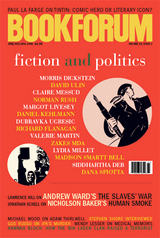
“An outbreak, like a story, should have a coherent plot.” That comment, from a well-known virologist, could easily serve as epigram or foil to Contagious, Priscilla Wald’s critique of the stories that the media and the medical profession have constructed about disease outbreaks from typhoid to HIV/aids to Ebola.
Wald painstakingly places pins in a map of twentieth-century culture, charting the rise of stock characters, settings, and plot twists. The accumulated conventions are on display, she argues, in many outbreak tales from the ’90s—books such as Richard Preston’s The Hot Zone and Laurie Garrett’s The Coming Plague and films such as Wolfgang Petersen’s Outbreak. In these accounts, we find disease emerging from “primitive” places like Africa. (At the start of Outbreak, the camera pans over the African treetops and sweeps down to soldiers battling in the jungle.) We find epidemiologists and researchers fighting a malevolent, near-mythic foe. (Under the microscope, Ebola in The Hot Zone resembles “white cobras tangled among themselves like the hair of Medusa.”) We find hidden connections between people laid bare, since, as Wald notes, “the interactions that make us sick also constitute us as a community.” And finally, of course, we find national salvation, with the heroic epidemiologist cast as “victorious storyteller and priestly guardian.”
Wald, a professor of English at Duke University, argues that these tales can have damaging consequences. They may lead us to scapegoat the sick or to focus on “primitiveness” or deviance as a cause of disease while overlooking the crucial role of poverty. Stock narrative can also reinforce nationalism and nativism, which compound the problems of the afflicted: “Suffering and death should not be accepted as inevitable in one place and unthinkable in another.” Wald suggests that more nuanced accounts might help to engender better responses to disease—and that argument is appealing as far as it goes. But the heart of her book does not lie with global health policy.
Rather, Wald is at her best when probing the literary and historical roots of today’s conventions, homing in on particular moments in the past. She is superb, for instance, in recalling how an immigrant Irish cook named Mary Mallon was deemed a typhoid carrier, recast as the notorious Typhoid Mary, and banished to an island off the Bronx. In the early twentieth century, the notion that a seemingly healthy person could carry and transmit disease was not yet established. But George Soper, an engineer in the US Army Sanitary Corps, sought to make the case, using Mallon as Exhibit A. He hoped that she would cooperate and enhance his reputation; in turn, he promised that she would benefit financially. Mallon, however, would have none of it. Refusing to believe that she was spreading disease and unwilling to meet with public-health officials, she earned herself a lifetime of vilification. Wald shows how Soper subsequently fixated on Mallon’s lack of cooperation, her dirty quarters, and her status as an unmarried, sexually active woman (though typhoid is not, in fact, a sexually transmitted disease). Even Mallon’s “affection for her lover’s dog” fueled Soper’s growing revulsion. As time went on, he and others turned Typhoid Mary into a monster, while promoting a moralistic tale that buttressed the case for tougher public-health programs and social controls. (Mallon, meanwhile, lived out her days in isolation, even as other typhoid carriers met with greater compassion.) Thus emerged the Typhoid Mary archetype—vengeful, foreign, fallen—that would resurface in subsequent tales.
Wald persuasively explicates how another staple of the outbreak genre—the insidious, subversive virus—came of age during the cold war. A signal moment arrived with Jack Finney’s 1955 novel, The Body Snatchers, in which malevolent “pod people” infiltrate a small town and rob much of it of its humanity. Wald identifies a link between microbes and “willful saboteurs,” reflecting anxieties about communism, spies, and brainwashing—not to mention plain old germs. In McCarthy-era America, the body politic was treated as “a kind of large-scale human immune system,” keeping watch for dangerous entities. Codes and information were newly central both to the state (in the form of classified documents) and to science (with the understanding that life is, in part, a system for passing on data). The threat of viruses, which corrupt information and hijack its machinery, thus roared with symbolic significance.
HIV/aids, however, does not quite fit Wald’s mold, as she points out. At first, the disease inspired some familiar narrative moves. In his 1987 best seller And the Band Played On, for instance, Randy Shilts emphasizes the role of a gay French-Canadian flight attendant named Gaetan Dugas in bringing the virus to North America and presents Dugas as an unrepentant Patient Zero, much in the mode of Typhoid Mary. But Dugas’s role was likely less central: “Anyone knowledgeable knows that to pin a global epidemic on the actions of a single individual is absurd,” noted a review in Science. The outbreak also inspired talk of the insidious brilliance of the retrovirus and celebrations of the “heroic epidemiologists” working to contain it, but no vaccine or cure was forthcoming. Instead, Wald argues, at least some of the popular anxiety about devastating outbreaks was displaced onto other epidemic tales, like The Hot Zone and Outbreak. Wald does not carry her analysis of HIV/aids through to the present (her paradigmatic disease of today is avian flu), but one might argue that with the twentieth anniversary of the discovery of aids in 2001 and recent media attention to massive, failed vaccine efforts (particularly those of Merck), the alternative paradigm—the narrative of unsolved outbreak—has come to occupy center stage. As Wald would no doubt agree, one coherent plot replaces another.
Amanda Schaffer is a science and medical columnist for Slate and a frequent contributor to Bookforum.
